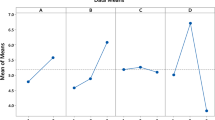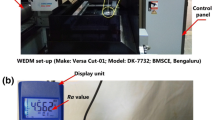Abstract
In order to machine hard and high-strength-to-weight ratio materials, electrical discharge machining (EDM) process is extensively used in aerospace, automobile and other industrial applications. However, high erosion of tool and improper selection of machining variables have emerged as a major obstruction to achieve productivity in this direction. High erosion of tool not only enhances the cost of machining but also increases the machining time by causing interruption during machining. Therefore, proper selection of machining variables and tool material life are the two vital aspects for the tool engineers working in EDM. In view of this, the present work proposes an extensive experimental investigation and optimization of machining variables of cryogenically treated brass tool materials on machining competences of Inconel 718 workpiece. The study primarily highlights the outcome of cryogenically treated soaking duration of tools along with other important process variables, viz. discharge current, open-circuit voltage, pulse-on time, duty factor and flushing pressure, on the performance measures such as electrode wear ratio (EWR), surface roughness and radial over-cut. The study revealed that soaking duration in deep cryo-treatment of the electrode is a significant variable to achieve improved machining characteristics. The performance measures are converted into equivalent single performance measure by calculating the relative closeness coefficient by the techniques for order preferences by similarity to ideal solution (TOPSIS) approach. Finally, a novel teaching–learning-based optimization (TLBO) algorithm has been proposed to find the optimal level of machining variables for the performance measures. The optimal levels of cutting variables obtained through the algorithm are validated through confirmation test, predicting an error of 2.171 percentages between the computational and experimental results. The predicted result suggests that the proposed model can be used to select the ideal process states to achieve productivity for the cryo-treated EDM.











Similar content being viewed by others
References
Lee S and Li X 2001 Study of the effect of machining parameters on the machining characteristics in electrical discharge machining of tungsten carbide. J. Mater. Process. Technol. 115(3): 344–358
Kuppan P, Narayanan S and Rajadurai A 2011 Effect of process parameters on material removal rate and surface roughness in electric discharge drilling of inconel 718 using graphite electrode. Int. J. Manuf. Technol. Manag. 23(3-4): 214–233
Kumar S, Singh R, Singh T and Sethi B 2009 Surface modification by electrical discharge machining: a review. J. Mater. Process. Technol. 209(8): 3675–3687
Kumar N, Kumar L, Tewatia H and Yadav R 2012 Comparative study for mrr on die-sinking edm using electrode of copper & graphite. Int. J. Adv. Technol. Eng. Res. 2(2): 170–174
Åhman L 1984 Microstructure and its effect on toughness and wear resistance of laser surface melted and post heat treated high speed steel. Metall. Trans. A 15(10): 1829–1835
Apachitei I, Tichelaar F, Duszczyk J and Katgerman L 2002 The effect of heat treatment on the structure and abrasive wear resistance of autocatalytic nip and nip–sic coatings. Surf. Coat. Technol. 149(2): 263–278
Kim H, Miyaji F, Kokubo T and Nakamura T 1997 Effect of heat treatment on apatite-forming ability of ti metal induced by alkali treatment. J. Mater. Sci. Mater. Med. 8(6): 341–347
Arockia Jaswin M and Mohan Lal D 2010 Optimization of the cryogenic treatment process for en 52 valve steel using the Grey–Taguchi method. Mater. Manuf. Process. 25(8): 842–850
Kumar A, Maheshwari S, Sharma C and Beri N 2012 Machining efficiency evaluation of cryogenically treated copper electrode in additive mixed edm. Mater. Manuf. Process. 27(10): 1051–1058
Jafferson J M and Hariharan P 2013 Machining performance of cryogenically treated electrodes in microelectric discharge machining: a comparative experimental study. Mater. Manuf. Process. 28(4): 397–402
Kapoor J, Singh S and Khamba J S 2012 Effect of cryogenic treated brass wire electrode on material removal rate in wire electrical discharge machining. Proc. Inst. Mech. Eng. C J. Mech. Eng. Sci. 226(11):2750–2758
Gill S S, Singh H, Singh R and Singh J 2010 Cryoprocessing of cutting tool materialsa review. Int. J. Adv. Manuf. Technol. 48(1): 175–192
Gill S S and Singh J 2010 Effect of deep cryogenic treatment on machinability of titanium alloy (ti-6246) in electric discharge drilling. Mater. Manuf. Process. 25(6): 378–385
Xu J, Liu Y, Wang J, Kui X, Gao Y and Xu Z 2007 A study on double glow plasma surface metallurgy mo–cr high speed steel of carbon steel. Surf. Coat. Technol. 201(9): 5093–5096
Lal D M, Renganarayanan S and Kalanidhi A 2001 Cryogenic treatment to augment wear resistance of tool and die steels. Cryogenics 41(3): 149–155
Collins D and Dormer J 1997 Deep cryogenic treatment of a d 2 cold-work tool steel. Heat Treat. Metals (UK) 24(3): 71–74
Mohanty C P, Mahapatra S S and Singh M R 2016 A particle swarm approach for multi-objective optimization of electrical discharge machining process. J. Intell. Manuf. 27(6): 1171–1190
Padhee S, Nayak N, Panda S, Dhal P and Mahapatra S 2012 Multi-objective parametric optimization of powder mixed electro-discharge machining using response surface methodology and non-dominated sorting genetic algorithm. Sadhana, pp. 1–18
Prabhu S and Vinayagan B K 2013 Multi objective optimisation of swcnt-based electrical discharge machining process using grey relational and fuzzy logic analysis. Int. J. Mach. Mach. Mater. 13(4): 439–463
Dewangan S and Biswas C K 2013 Optimisation of machining parameters using grey relation analysis for edm with impulse flushing. Int. J. Mechatron. Manuf. Syst. 6(2): 144–158
El-Taweel T A and Hewidy M S 2009 Enhancing the performance of electrical-discharge machining via various planetary modes. Int. J. Mach. Mach. Mater. 5(2–3):308–320
Dewangan S, Gangopadhyay S and Biswas C 2015 Study of surface integrity and dimensional accuracy in edm using fuzzy topsis and sensitivity analysis. Measurement 63: 364–376
Puhan D, Mahapatra S S, Sahu J and Das L 2013 A hybrid approach for multi-response optimization of non-conventional machining on alsic p mmc. Measurement 46(9): 3581–3592
Selvarajan L, Narayanan C S, Jeyapaul R and Manohar M 2016 Optimization of edm process parameters in machining si 3 n 4–tin conductive ceramic composites to improve form and orientation tolerances. Measurement 92: 114–129
Srivastava V and Pandey P M 2011 Study of the cryogenically cooled electrode shape in electric discharge machining process. In: Conference Proceedings of the World Academy of Science, Engineering and Technology, vol. 60, pp. 1017–1021
Abdulkareem S, Khan A A and Konneh M 2009 Reducing electrode wear ratio using cryogenic cooling during electrical discharge machining. Int. J. Adv. Manuf. Technol. 45(11): 1146–1151
Srivastava V and Pandey P M 2012 Performance evaluation of electrical discharge machining (edm) process using cryogenically cooled electrode. Mater. Manuf. Process. 27(6): 683–688
Joshi S and Pande S 2009 Development of an intelligent process model for edm. Int. J. Adv. Manuf. Technol. 45(3): 300–317
Joshi S N and Pande S 2010 Thermo-physical modeling of die-sinking edm process. J. Manuf. Process. 12(1): 45–56
Paramashivan S S, Mathew J and Mahadevan S 2012 Mathematical modeling of aerosol emission from die sinking electrical discharge machining process. Appl. Math. Modell. 36(4): 1493–1503
Chen Y and Mahdivian SM 2000 Analysis of electro-discharge machining process and its comparison with experiments. J. Mater. Process. Technol. 104(1): 150–157
Mohanty C P, Sahu J and Mahapatra S S 2013 Thermal–structural analysis of electrical discharge machining process. Proc. Eng. 51: 508–513
Singh S, Maheshwari S and Pandey P 2004 Some investigations into the electric discharge machining of hardened tool steel using different electrode materials. J. Mater. Process. Technol. 149(1): 272–277
Kumar V and Kumar P 2015 Experimental investigation of the process parameters in cryogenic cooled electrode in edm. J. Mech. Sci. Technol. 29(9): 3865–3871
Tzeng G H and Huang J J 2011 Multiple attribute decision making: methods and applications. Chapman and Hall/CRC
Jayakumar D N and Venkatesh P 2014 Glowworm swarm optimization algorithm with topsis for solving multiple objective environmental economic dispatch problem. Appl. Soft Comput. 23: 375–386
Behzadian M, Otaghsara S K, Yazdani M and Ignatius J 2012 A state-of the-art survey of topsis applications. Expert Syst. Appl. 39(17): 13051–13069
Mogale D, Dolgui A, Kandhway R, Kumar S K and Tiwari M K 2017 A multi-period inventory transportation model for tactical planning of food grain supply chain. Comput. Ind. Eng. 110: 379 – 394
Maiyar L M and Thakkar J J 2017 A combined tactical and operational deterministic food grain transportation model: Particle swarm based optimization approach. Comput. Ind. Eng. 110: 30 – 42
Rao R V, Rai D P and Balic J 2017 A multi-objective algorithm for optimization of modern machining processes. Eng. Appl. Artif. Intell. 61: 103 – 125
Mogale D, Kumar S K, Mrquez F P G and Tiwari M K 2017 Bulk wheat transportation and storage problem of public distribution system. Comput. Ind. Eng. 104: 80 – 97
Rao R V and Savsani V J 2012 Mechanical design optimization using advanced optimization techniques. Springer Science & Business Media
Rao R V, Savsani V J and Vakharia D P 2012 Teaching–learning-based optimization: an optimization method for continuous non-linear large scale problems. Inf. Sci. 183(1): 1–15
Li J-Q, Pan Q-K and Mao K 2015 A discrete teaching-learning-based optimisation algorithm for realistic flowshop rescheduling problems. Eng. Appl. Artif. Intell. 37:279–292
Ghasemi M, Ghanbarian M M, Ghavidel S, Rahmani S and Moghaddam E M (2014) Modified teaching learning algorithm and double differential evolution algorithm for optimal reactive power dispatch problem: a comparative study. Inf. Sci. 278: 231–249
Tiwari A and Pradhan M 2017 Applications of tlbo algorithm on various manufacturing processes: a review. Materials Today: Proceedings, vol. 4, no. 2, Part A, pp. 1644 – 1652, 2017, In: 5th International Conference of Materials Processing and Characterization (ICMPC 2016)
Rao R V, More K C, Taler J and Ocłoń P 2016 Optimal design of stirling heat engine using an advanced optimization algorithm. Sadhana 41(11): 1321–1331
Rao R V, Savsani V J and Vakharia D 2011 Teaching–learning-based optimization: a novel method for constrained mechanical design optimization problems. Comput. Aided Des. 43(3): 303–315
Mohanty C P 2015 Studies on some aspects of multi-objective optimization: a case study of electrical discharge machining process, Ph.D. dissertation
Acknowledgements
The experimental data collected for this study are based on the Doctoral thesis submitted to National Institute of Technology, Rourkela, authored by Dr. Chinmaya Prasad Mohanty, i.e., by the first author of this manuscript. The authors thank National Institute of Technology, Rourkela, India, for providing their facilities and resources to carry out the research work. It is hereby declared that the material present in the manuscript is the original research carried out by the authors. No part of this manuscript or the entire manuscript has been submitted to any conference or journal. The thesis has been also cited in the manuscript. For further clarification, the following link of the thesis submitted to National Institute of Technology, Rourkela, is also provided: http://ethesis.nitrkl.ac.in/6915/1/Chinmaya_511ME123_PhD_2015.pdf
Author information
Authors and Affiliations
Corresponding author
Rights and permissions
About this article
Cite this article
MOHANTY, C.P., SATPATHY, M.P., MAHAPATRA, S.S. et al. Optimization of cryo-treated EDM variables using TOPSIS-based TLBO algorithm. Sādhanā 43, 51 (2018). https://doi.org/10.1007/s12046-018-0829-7
Received:
Revised:
Accepted:
Published:
DOI: https://doi.org/10.1007/s12046-018-0829-7




